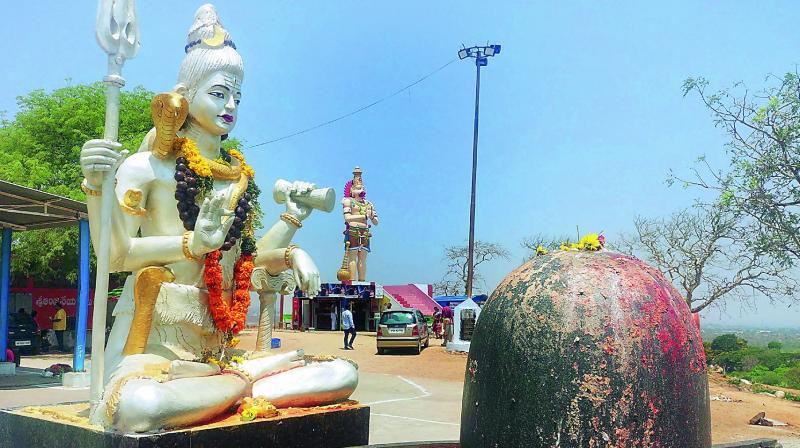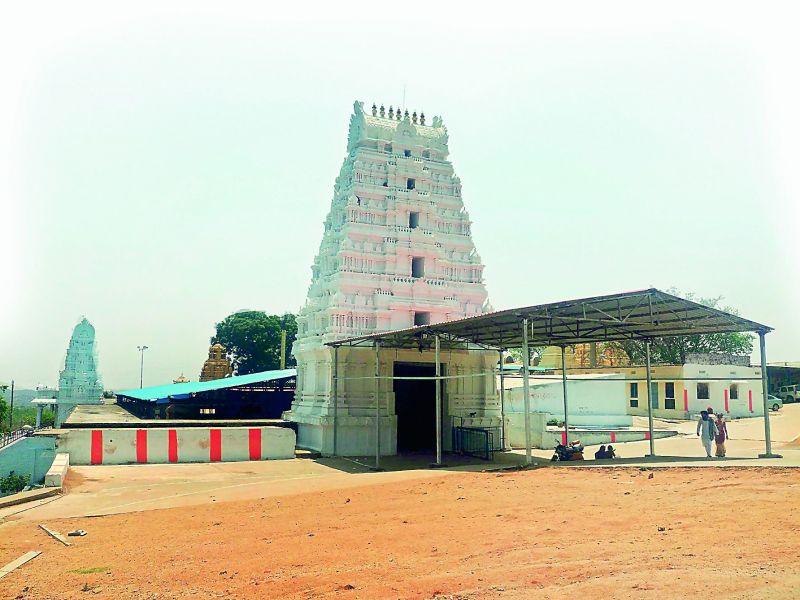101 lingas are worshiped here
Lord Rama needed a Shiva linga to do puja and so sent his ever present doota, Lord Hanuman to Varanasi to bring it.

Hyderabad: For a long time, and even now Keesaragutta has always been known as a picnic spot.
It’s not too far from the city, but yet far enough for an adventure. Its spacious open areas and 101 Shiva Linga’s to worship, attract crowds.
Legend has it that when Lord Rama returned from Lanka after killing Ravana, he felt a certain guilt that he had done ‘Brahma Hatya’, the sin of killing the demon King Ravana, a Brahmin. In due process he found this place, a valley surrounded by a thick forest in those days.

Lord Rama needed a Shiva linga to do puja and so sent his ever present doota, Lord Hanuman to Varanasi to bring it. As the auspicious time was approaching, Lord Rama prayed and Lord Siva self-manifested here in the form of a linga.
But there being a timing for everything, the muhurtam or good timing for the puja was getting along and so the legend was that Lord Shiva himself appeared before Lord Rama and handed over a lingam asking him to proceed with the puja.
Meanwhile, Lord Hanuman arrived, the delay being because of the selection of lingams.
Instead of one, he wanted to give his Lord a choice and so brought 101 of them. But when he arrived he saw that his trip came to nought as the puja had already started.
It is said that Lord Rama asked him to return the lingams to Varanasi but Hanuman in disappointment or anger threw them away. Thus Keesaragutta got 101 lingams around the temple and one ‘Swayambhu’ lingam to worship within the temple. The lingams fell within a 9-metre radius making it much easier for the worshiper.
In fact, in recent times, Mr Kandaswami, son-in-law of the late director K. Balachander, visited this temple for the first time and went away very impressed. So much so, that at night Lord Hanuman came in his dreams and told him he had not thrown the lingams in anger. When he (Lord Hanuman) saw that Lord Rama had started the puja, he folded his hands in respect and the 101 lingams thus fell down. This too then would go down as a legend.
The temple is also called Ramalingeswara Devalayam as the main deity was Sri Ramalingeshwara, since Lord Rama had set up the lingam.
Since Hanuman was Lord Rama’s favourite, the Lord to pacify the miffed doota said that precedence would be given to him for worship at the temple. This was the explanation for the tall Hanuman figure on the right side as one climbs the steps to enter the temple. Lord Rama also said that the hillock where the Shivalingam was installed would bear Hanuman’s name or Kesarigiri, the son of Kesari. Over a period of time, it was called Keesara and the hill as Keesaragutta.
Earlier, there was no road to the temple and it was a tough trek, but after 1979, a lot of development took place and the then Chief Minister M. Channa Reddy built the gali gopuram for the temple run by the hereditary priests.
The archaeological department conducted several excavations in the surrounding areas and some brick structures and Shiva lingas were found. There is a beautiful lake just behind the temple with an arch near the temple which looks on to the lake and another from the lake leads to another with a very Moghul look. There is a mandapam near the lake and another building which could have been the yagnashala.
As per the archaeological department findings, remnants and rock-cut cisterns were found on the hills as an indication of Jainism and Buddhism that flourished during that period. On October 18, 2014, twelve idols of Jain Tirthankaras dating back to the 4th-5th century were found near the temple steps at a depth of one foot, substantiating the theory that Jainism co-existed with Hinduism during the time of Vishnukundins in 4th-5th century. Historical ruins suggested that the temple might have been built during the 4th or 5th century AD. The architecture apparently reflected the Gupta period. From the inscriptions, it is known that Vishnu Kundina kings ruled this region during 4th and 7th century AD.
The Thatakam family are the hereditary pujaris working hard to develop the temple and are the founder trustees or dharma kartas of the temple. The Deepa stambham is in the Vishunukundini structure, with the boar, fish and the tortoise embedded at the base. On the four sides of the pillar are Ganesh, Hanuman and Kala Bhairava or the God of time. The Keesaragutta temple is dedicated to Lord Shiva and two of his consorts, Shivadurga and Bhavani and hence one of the popular festivals is Shivaratri. Summer months are a bit harsh, but that does not stop people from visiting the temple and spending time there.

